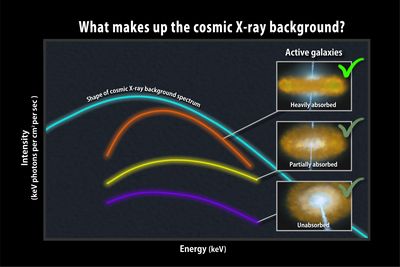
A newfound population of heavily absorbed active galaxies (orange curve) is thought to make the greatest contribution to the cosmic X-ray background (light blue). Both have similar spectral shapes and peak at similar energies. Adding in the known contributions from less-absorbed active galaxies (yellow and purple) appears to fully account for the background. Credit: NASA/Goddard Space Flight Center
Most large galaxies contain a giant central black hole, and those observed in the Swift study weigh in at about 100 million times the sun's mass. In an active galaxy, matter falling toward the supermassive black hole powers high-energy emissions so intense that two classes of active galaxies, quasars and blazars, rank as the most luminous objects in the universe.
The X-ray background led astronomers to suspect that active galaxies were undercounted. Astronomers could never be certain that they had detected most of even the closest active galaxies. Thick clouds of dust and gas surround the central black hole and screen out ultraviolet, optical and low-energy (or soft) X-ray light. While infrared radiation can make it through the material, it can be confused with warm dust in the galaxy's star-forming regions.
See the website for more details. http://www.nasa.gov/mission_pages/swift/main/index.html(SY)
